Attached files
| file | filename |
|---|---|
| 8-K/A - AMENDMENT NO. 1 TO FORM 8-K - ENDURANCE SPECIALTY HOLDINGS LTD | d400422d8ka.htm |
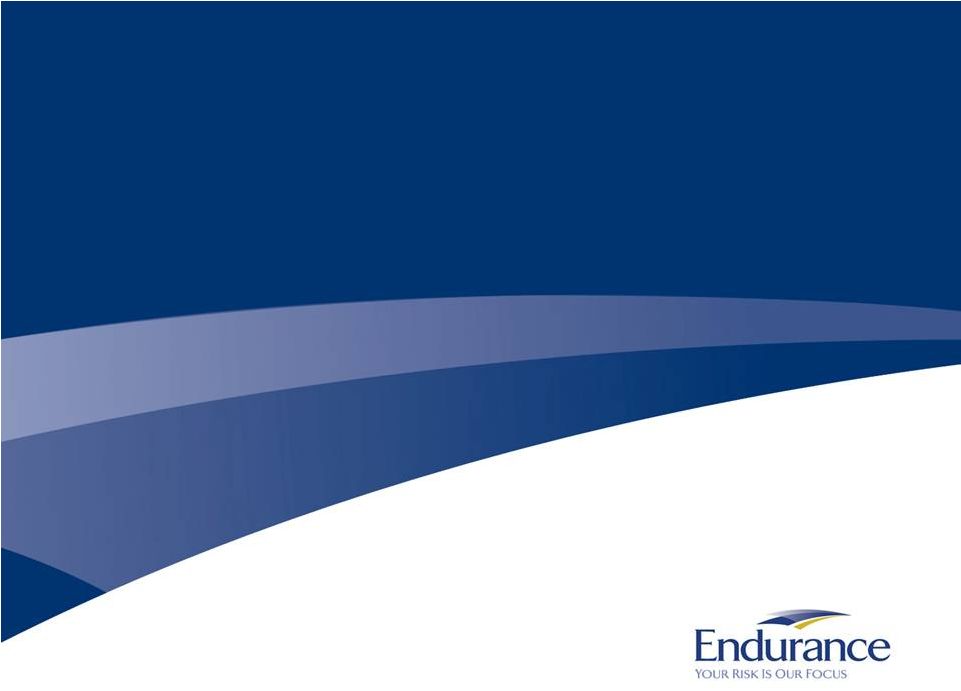 Endurance
Specialty Holdings Investor Presentation
Exhibit 99.1 |
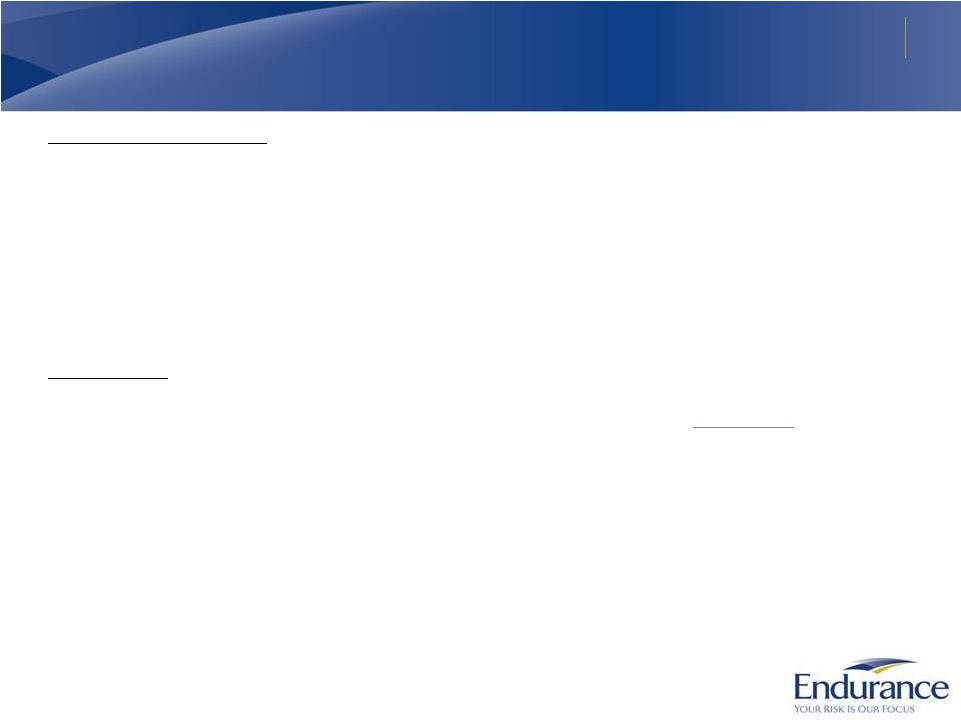 Safe Harbor for
Forward Looking Statements Some of the statements in this presentation may
include forward-looking statements which reflect our current views with respect to future events and financial performance.
Such statements include forward-looking statements both with respect to us in general and the
insurance and reinsurance sectors specifically, both as to underwriting and investment matters.
Statements which include the words “should”,"expect," "intend," "plan," "believe," "project," "anticipate," "seek," "will," and similar statements of a future
or forward-looking nature identify forward-looking statements in this presentation for
purposes of the U.S. federal securities laws or otherwise. We intend these forward- looking
statements to be covered by the safe harbor provisions for forward-looking statements in the Private Securities Litigation Reform Act of 1995.
All forward-looking statements address matters that involve risks and uncertainties.
Accordingly, there are or may be important factors that could cause actual results to differ
from those indicated in the forward-looking statements. These factors include, but are not limited to, the effects of competitors’ pricing policies, greater frequency or
severity of claims and loss activity, changes in market conditions in the agriculture insurance
industry, termination of or changes in the terms of the U.S. multiple peril crop insurance
program, a decreased demand for property and casualty insurance or reinsurance, changes in the availability, cost or quality of reinsurance or retrocessional
coverage, our inability to renew business previously underwritten or acquired, our inability to
maintain our applicable financial strength ratings, our inability to effectively integrate
acquired operations, uncertainties in our reserving process, changes to our tax status, changes in insurance regulations, reduced acceptance of our existing or
new products and services, a loss of business from and credit risk related to our broker
counterparties, assessments for high risk or otherwise uninsured individuals, possible
terrorism or the outbreak of war, a loss of key personnel, political conditions, changes in insurance regulation, changes in accounting policies, our investment
performance, the valuation of our invested assets, a breach of our investment guidelines, the
unavailability of capital in the future, developments in the world’s financial and capital
markets and our access to such markets, government intervention in the insurance and reinsurance industry, illiquidity in the credit markets, changes in general
economic conditions and other factors described in our most recently filed Annual Report on Form
10-K . Forward-looking statements speak only as of the date on which they are
made, and we undertake no obligation publicly to update or revise any forward-looking statement,
whether as a result of new information, future developments or otherwise.
Regulation G Disclaimer
In presenting the Company’s results, management has included and discussed certain non-GAAP
measures. Management believes that these non-GAAP measures, which may be defined
differently by other companies, better explain the Company's results of operations in a manner that allows for a more complete understanding of the
underlying trends in the Company's business. However, these measures should not be viewed as a
substitute for those determined in accordance with GAAP. For a complete description of
non-GAAP measures and reconciliations, please review the Investor Financial Supplement on our web site at www.endurance.bm.
The combined ratio is the sum of the loss, acquisition expense and general and administrative expense
ratios. Endurance presents the combined ratio as a measure that is commonly recognized as
a standard of performance by investors, analysts, rating agencies and other users of its financial information. The combined ratio, excluding prior
year net loss reserve development, enables investors, analysts, rating agencies and other users of its
financial information to more easily analyze Endurance’s results of underwriting
activities in a manner similar to how management analyzes Endurance’s underlying business performance. The combined ratio, excluding prior year net loss
reserve development, should not be viewed as a substitute for the combined ratio.
Net premiums written is a non-GAAP internal performance measure used by Endurance in the
management of its operations. Net premiums written represents net premiums written and
deposit premiums, which are premiums on contracts that are deemed as either transferring only significant timing risk or transferring only significant
underwriting risk and thus are required to be accounted for under GAAP as deposits. Endurance
believes these amounts are significant to its business and underwriting process and excluding
them distorts the analysis of its premium trends. In addition to presenting gross premiums written determined in accordance with GAAP, Endurance
believes that net premiums written enables investors, analysts, rating agencies and other users of its
financial information to more easily analyze Endurance’s results of underwriting
activities in a manner similar to how management analyzes Endurance’s underlying business performance. Net premiums written should not be viewed as a
substitute for gross premiums written determined in accordance with GAAP.
Return on Average Equity (ROAE) is comprised using the average common equity calculated as the
arithmetic average of the beginning and ending common equity balances for stated periods.
Return on Beginning Equity (ROBE) is comprised using the beginning common equity for stated periods. The Company presents various
measures of Return on Equity that are commonly recognized as a standard of performance by investors,
analysts, rating agencies and other users of its financial information.
Forward looking statements & regulation G disclaimer
2 |
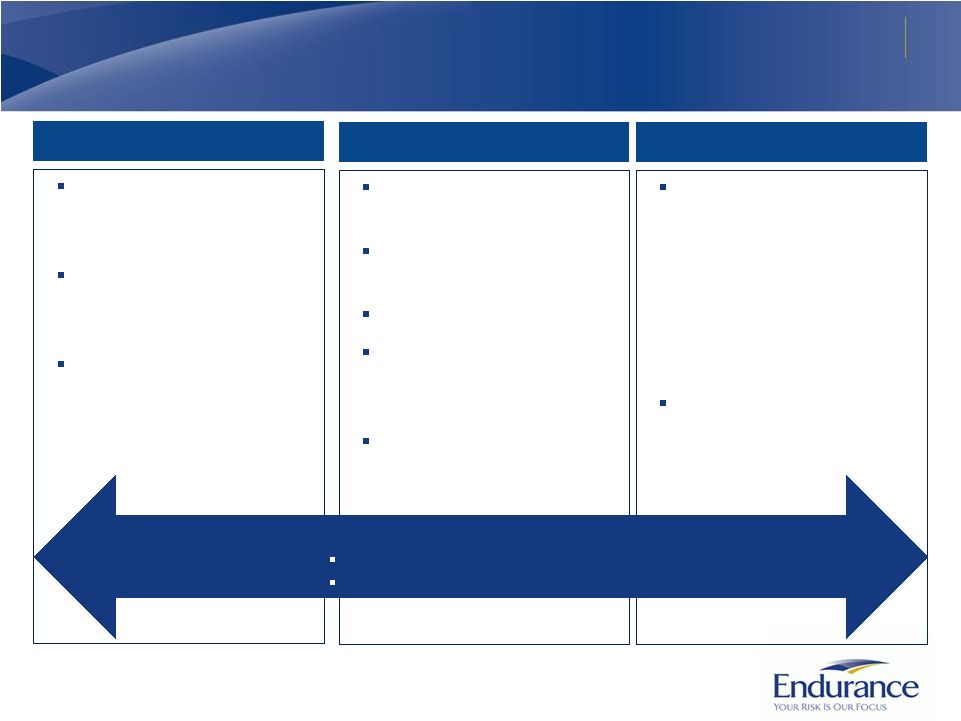 3
Introduction to Endurance Specialty Holdings
(Re)insurance company focused on diversified portfolio of businesses within specialty niches
Diversified Portfolio of Businesses
Evenly split between
insurance and reinsurance
businesses
Maintain strong balance of
specialty, property and
casualty exposures
Track record of
opportunistically entering
and exiting businesses to
achieve strong returns
Strong Balance Sheet
“A”
ratings from AM Best,
S&P and Moody’s
Excellent ERM ranking
from S&P
$3.3 billion of total capital
Conservative, low-
duration, AA rated
investment portfolio
Prudent reserves that
have historically been a
source of value
Active Capital Management
Returned $1.9 billion to
investors through
dividends and share
repurchases
•
Represents 77.2% of
inception to date net
income available to
common shareholders
Maintain a diversified ,
efficient capital structure
We have built a strong franchise in our first ten years of operation
Inception to date operating ROE of 11.8%
10 year book value per share plus dividends CAGR of 12.1% |
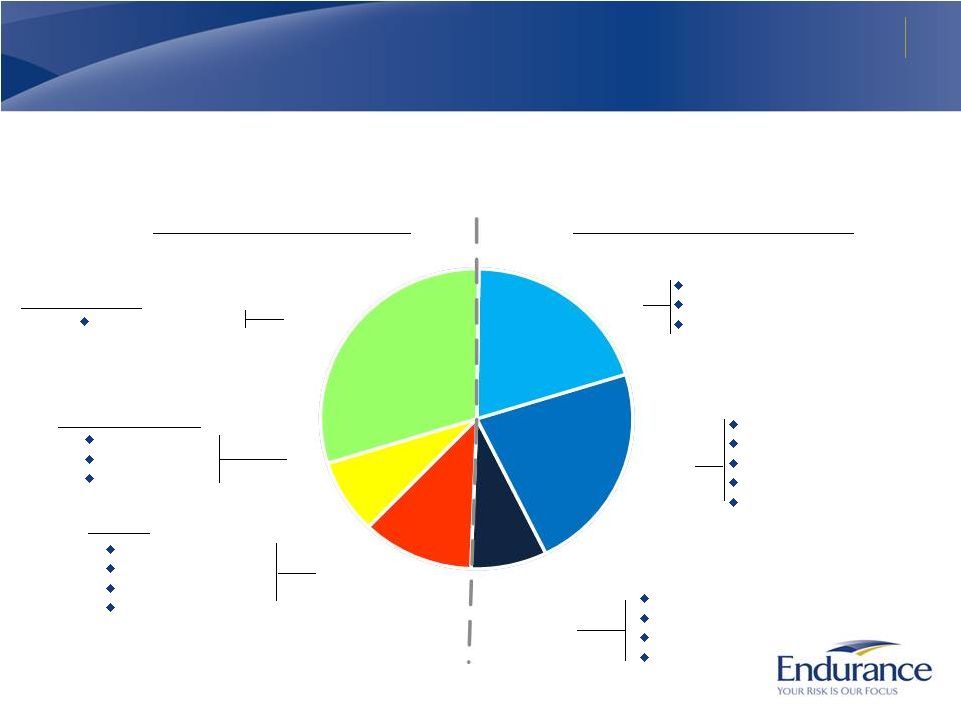 4
Diversified Portfolio of Businesses
Portfolio diversified by product, distribution source and geography
Trailing
Twelve
Months
Net
Premiums
Written
as
of
June
30,
2012:
$2.1
BN
Reinsurance
–
by
Geographic
Market
Insurance -
by Distribution Source
Casualty
Professional Liability
Property Per Risk
Small Business
Surety
International Property Catastrophe
US Property Catastrophe
Other Specialty (Aviation, Clash)
ARMtech Agriculture
US Property
US Casualty
US Miscellaneous E&O
Environmental
Healthcare
Excess Casualty
Professional Lines
International
7%
Global Excess
8%
U.S. Wholesale
11%
Bermuda
21%
Americas
23%
Casualty
Professional Lines
Property
Marine
Small Risk
30%
Independent Agents
Brokers
–
Bermuda/U.S.
Wholesale |
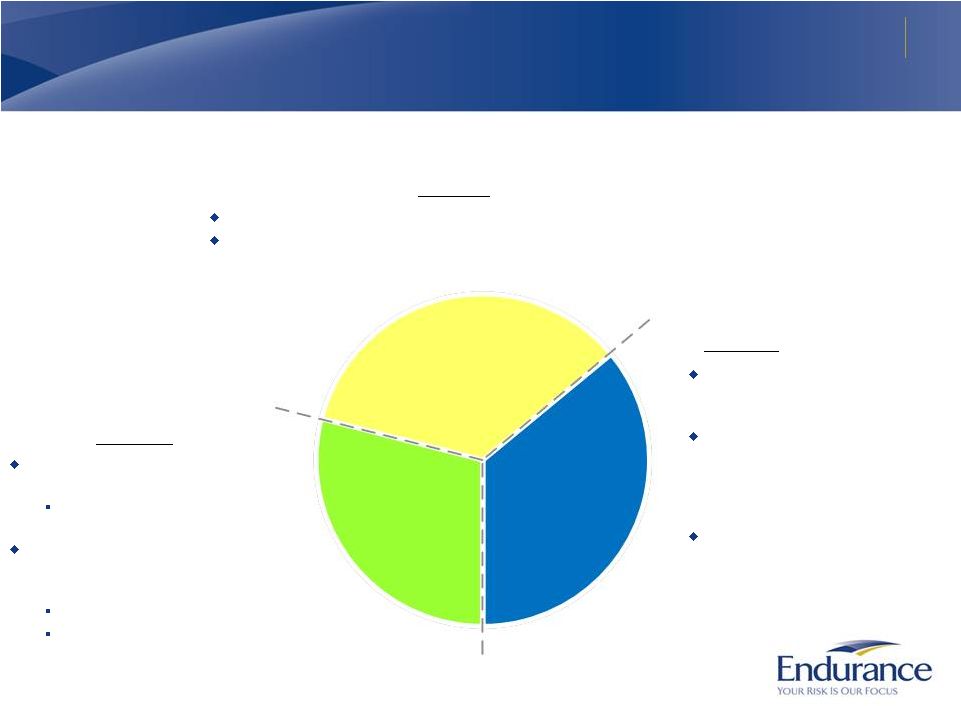 5
Balanced Portfolio of Diversified Risk Types
Adjusted product growth and capital deployment based on market conditions
Trailing Twelve Months Net Premiums Written as of June 30, 2012:
$2.1 BN
Property
(33%)
Casualty
(32%)
Property reinsurance has started
to expand based on improved
pricing and growth in Europe
Catastrophe reinsurance
expanded at mid -year renewals
as pricing improved and capital
was transferred from all risk
insurance business line
Property insurance premiums
reduced due to transfer of
capital away from all risk
insurance business line
Agriculture insurance is not linked to
property-casualty pricing cycle
We have expanded policy count by
40.4% since 2007
Aerospace, marine, surety and other
reinsurance lines of business have declined
significantly from their peaks
Exited offshore energy following KRW
Reduced premiums as competition
has increased
Specialty
(35%)
Casualty reinsurance reduced significantly since its peak in 2004
Casualty insurance lines of business have increased modestly since 2005 as
growth in middle market U.S. based business has been partially offset by declines
in Bermuda based large account business |
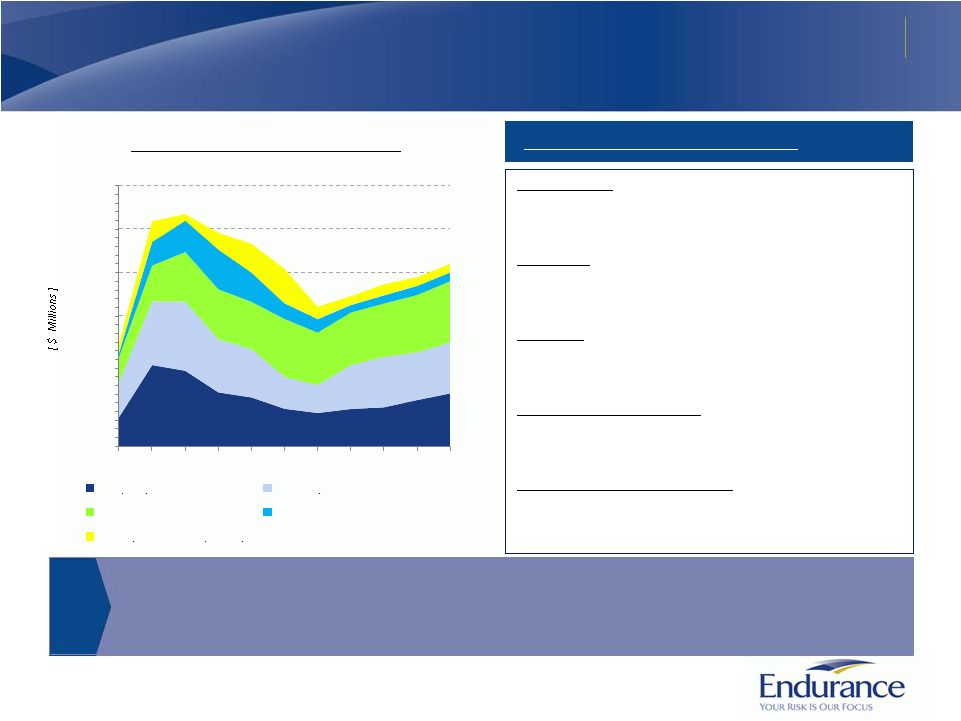 6
,
Current market conditions are improving within the catastrophe and property lines of business
where non- impacted areas are seeing modest price improvements while impacted areas
are experiencing significant price increases. Casualty pricing is showing signs
of stabilization as the markets appear to be coming out of the bottom of the
cycle. Opportunistic Reinsurance Portfolio Management
Reinsurance book has been actively managed through market cycles
Managing the Reinsurance Portfolio
* Trailing Twelve Months
Catastrophe
-
Premiums have grown in line with
our capital base and pricing has improved
following global cat losses in 2011
Property -
Premiums have declined 35% since 2003
as prices softened, but have begun to grow in
more recent periods on improved pricing
Casualty
-
Casualty has declined 26% from its peak
in 2004 and recent growth is in shorter tail,
smaller case casualty lines
Aerospace and Marine -
Premiums have declined
78% from 2005 peak as we exited the offshore
energy market and managed exposures
Surety and Other Specialty - Continue to
maintain a core portfolio while remaining disciplined in a
soft market
Reinsurance Net Written Premiums
$0
$250
$500
$750
$1
000
$1
250
$1
500
2002
2003
2004
2005
2006
2007
2008
2009
2010
2011
2012
TTM*
Property
Casualty
Catastrophe
Aerospace and Marine
Surety and Other Specialty |
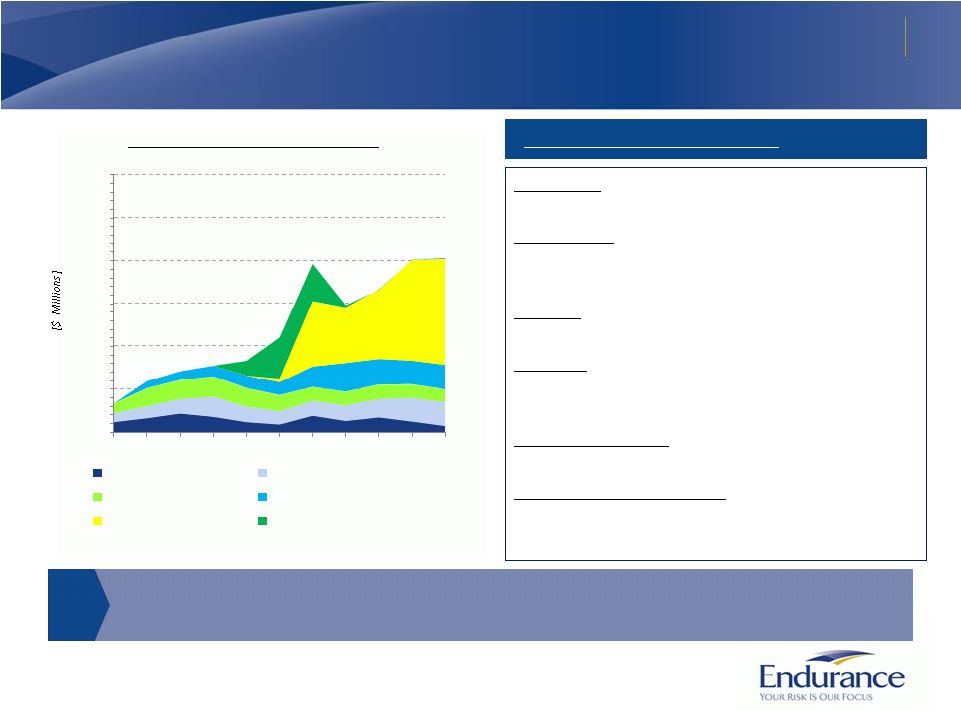 Diversified
Insurance Portfolio Continue to expand insurance capabilities while maintaining
discipline Insurance Net Written Premiums
Managing the Insurance Portfolio
Market conditions are improving as E&S casualty business is experiencing modest rate
improvement, especially for smaller contracts. Larger account professional
lines and excess casualty are experiencing a moderation of price reductions as the
market approaches the bottom of the cycle. * Trailing Twelve Months
$0
$250
$500
$750
$1
000
$1
250
$1,500
2002
2003
2004
2005
2006
2007
2008
2009
2010
2011
2012
TTM*
Property
Casualty
Healthcare Liability
Professional
Agriculture
Surety and Other Specialty
Agriculture
–
Strong growth supported by industry
leading technology and customer service.
Professional
–
Recent growth driven by growth in
small case products in the U.S while reducing our
exposures to large case products
Casualty
–
Growth has focused on small case market
where competition has been lower
Property
–
Reducing our exposures within E&S
property lines due to changes in RMS 11.0 and
from reductions in all risk product offer in this line
Healthcare Liability
–
Shrinking historically profitable
line that has attracted aggressive competition
Surety and Other Specialty – Historically
consisted of California’s Workers’
Compensation that we
exited in 2009
7 |
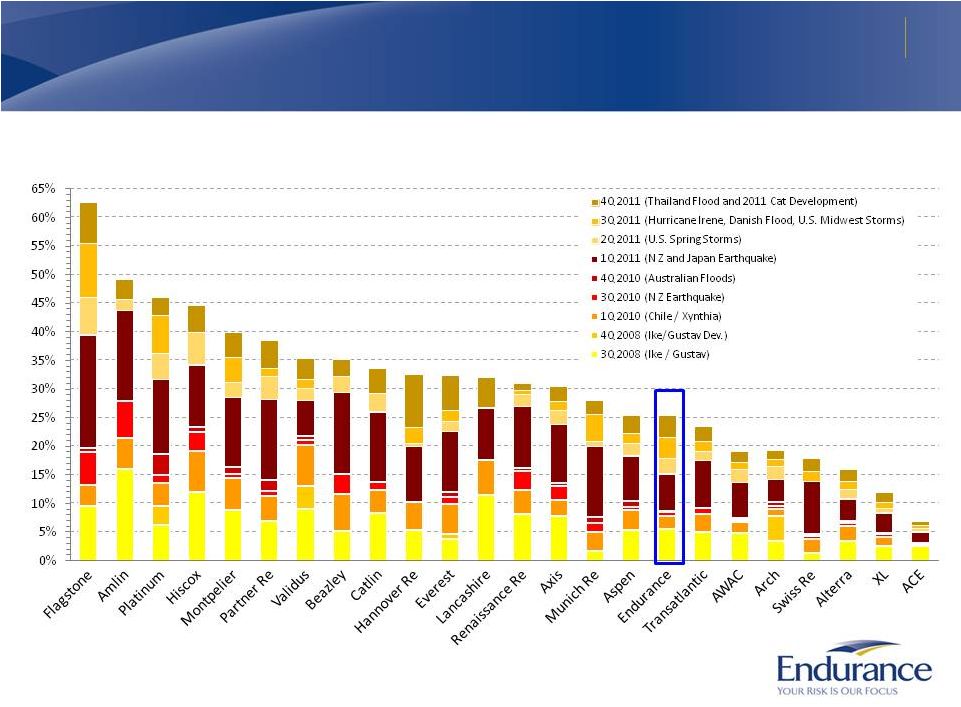 Endurance is
World Class at Risk Management Endurance has performed well versus peers in recent large
catastrophe events 8
Five Year Catastrophe Losses versus Shareholder Equity
From
December
31,
2006
–
December
31,
2011
Note:
Catastrophe loss values were obtained through publicly released information and company
transcripts for each quarter and include current quarter losses as well as announced
loss reserve development associated with prior quarter catastrophe losses.
Catastrophe losses are compared with starting Total Shareholder Equity for each loss
quarter. |
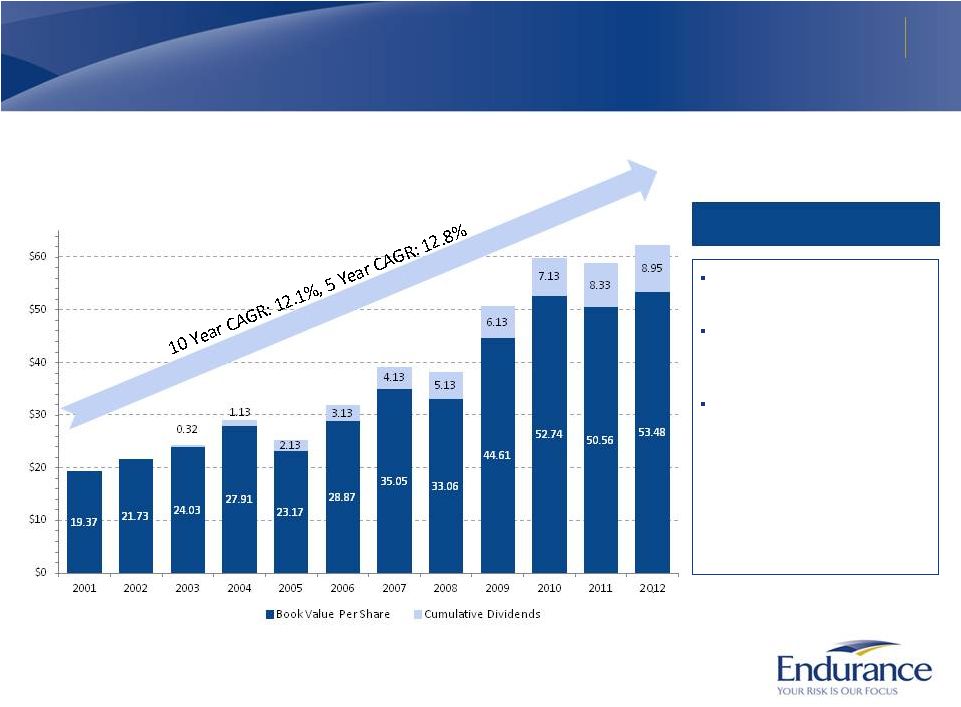 9
Endurance’s Financial Results
Diluted book value per common share has grown tremendously in absolute terms…
Growth in Diluted Book Value Per Common Share ($)
From
December
31,
2001
–
June
30,
2012
Note:
Diluted Book Value Per Share calculated on weighted number of average diluted shares
outstanding. 2005 –
Hurricanes Katrina, Rita
and Wilma
2008 –
Credit crisis and related
impact of marking assets to
market
2011 –
High frequency of
global catastrophes
(Earthquakes impacting New
Zealand and Japan, Hurricane
Irene, Texas wildfires, Thailand
and Australian Floods, Danish
Cloudburst, and a record level
of tornadoes in the United
States)
Significant Impacts to Book Value |
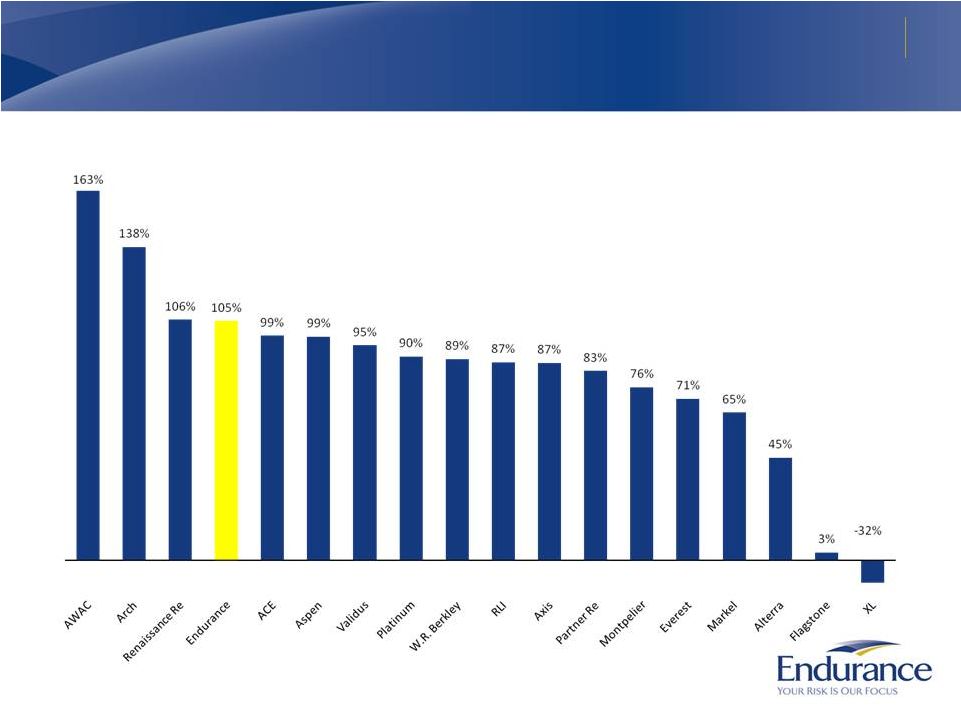 Endurance’s Financial Results
Book value per common share growth compares favorably to peers
10
Diluted Book Value Per Share Plus Dividend Growth
From
December
31,
2006
–
June
30,
2012
Note: Fully Diluted Book value per share and dividend data provided by company press releases
and filings. For those companies that do not disclose fully diluted book value
per share, the dilution was calculated using average diluted shares
outstanding. |
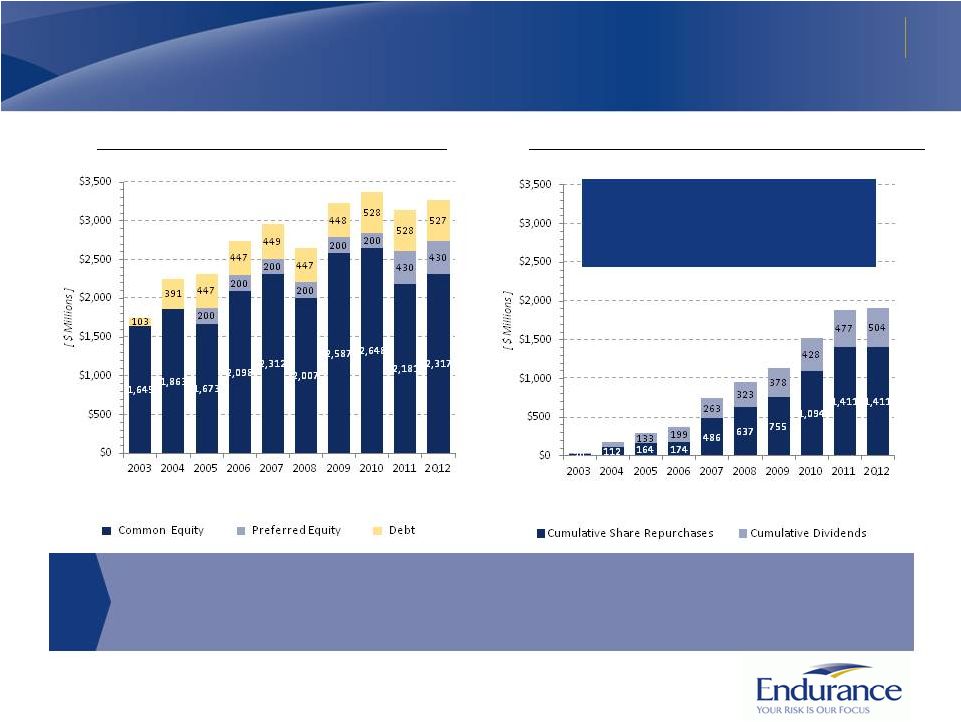 Growing
Capital Base while returning Capital to Investors Diluted shares outstanding have been
reduced by approximately 40% in the last five years Endurance has a Diversified and
Growing Capital Base $1.9 Billion of Capital Cumulatively Returned to
Shareholders 11
Endurance has proven its ability to generate capital which has allowed for the return to its
shareholders of $1.9 billion through share repurchases and dividends while also
supporting organic growth. Current capital
levels
exceed
rating
agency
minimum
levels
allowing
for
the
possibility
of
opportunistic
growth
in the
event that markets harden.
Returned 77.2% of inception to
date net income to common
shareholders |
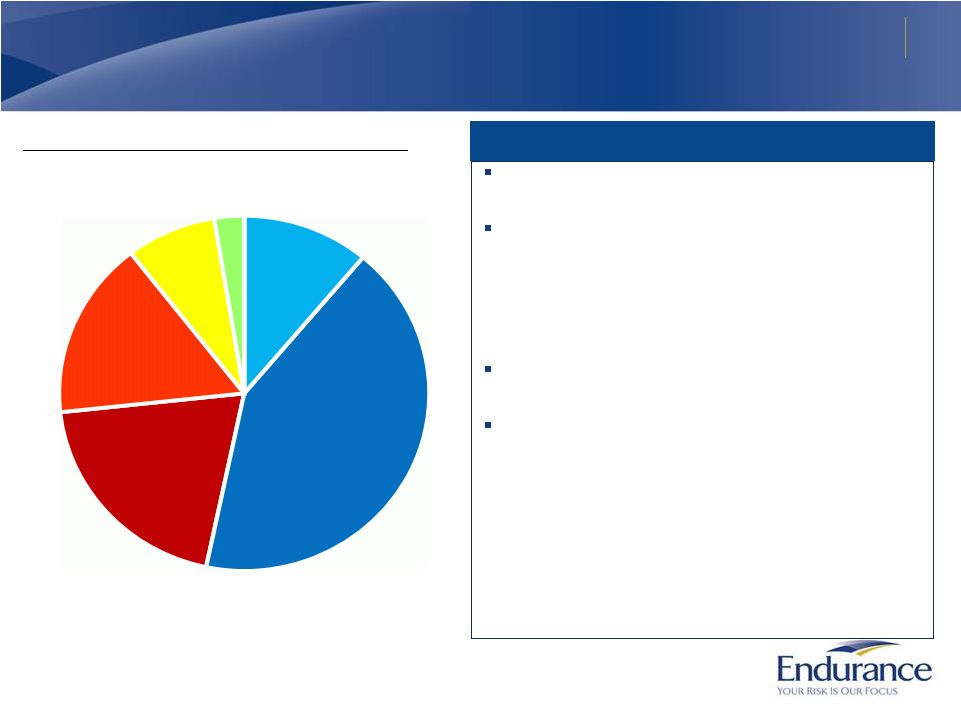 Strong Balance
Sheet Endurance maintains a high quality, short duration investment portfolio
$6.4 B Investment Portfolio at June 30, 2012
Investment Portfolio Highlights
Fixed maturity portfolio duration remains short at
2.60 years
Investment quality (AA average) has remained high as
the portfolio is conservatively managed in challenging
economy
•
52.0% of investments are cash/short term or US backed
•
No direct exposure to sovereign debt or bank debt of
European peripheral countries
Expanded into equities in 2011 to diversify portfolio
and reduce interest rate risk
Other investments of $478.9 million consist of
alternative funds (71.2%) and specialty funds (28.8%)
•
Alternative funds include hedge funds and private equity
funds
•
Specialty funds include high yield loan and convertible debt
funds
•
Other investments returns have significantly outperformed
S&P 500 with half the volatility since programs incepted
12
Cash and
Short Term
11.4%
U.S. Government /
and U.S. Government
Backed –
40.6%
Municipals and Foreign
Government
3.1%
Other Investments
and Equities
8.6%
Asset Backed and
Non Agency Mortgage
Backed –
16.9%
Corporate
Securities
19.4% |
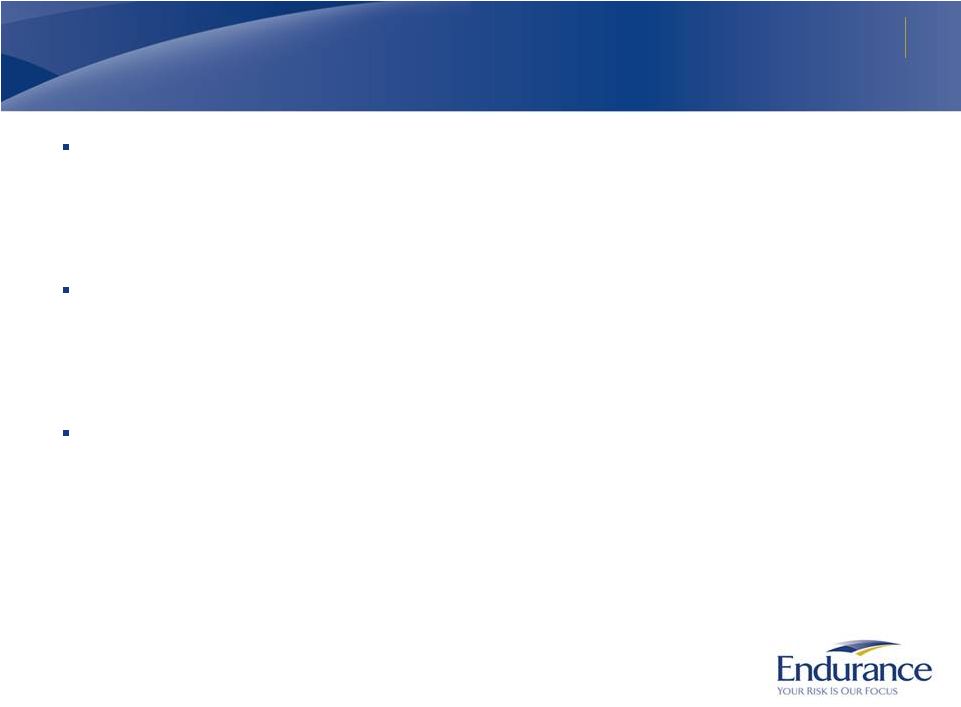 Conclusion
Endurance is a compelling investment opportunity
Strategically manage our businesses
•
Selectively reduced reinsurance premiums, especially in competitive longer tail lines
•
Shifted capital from all risk insurance business line to property catastrophe reinsurance
business line •
Active capital deployment to return excess capital to shareholders
-
Reduced diluted shares outstanding by approximately 40% in the last five years
Maintain excellent balance sheet strength and liquidity
•
High quality, short duration investment portfolio; fixed maturity investments have an average
credit quality of AA •
Prudent reserving philosophy and strong reserve position; strong
history of favorable development
•
Industry leading Enterprise Risk Management
•
Capital levels well in excess of rating agency minimums provide flexibility to grow in
potentially hardening markets The outlook for Endurance’s book of business remains
attractive •
Experiencing improved pricing across most of our lines of business
•
Catastrophe lines have remained disciplined and profitable and market conditions are
improving •
Small account casualty insurance lines are experiencing rate hardening
13 |
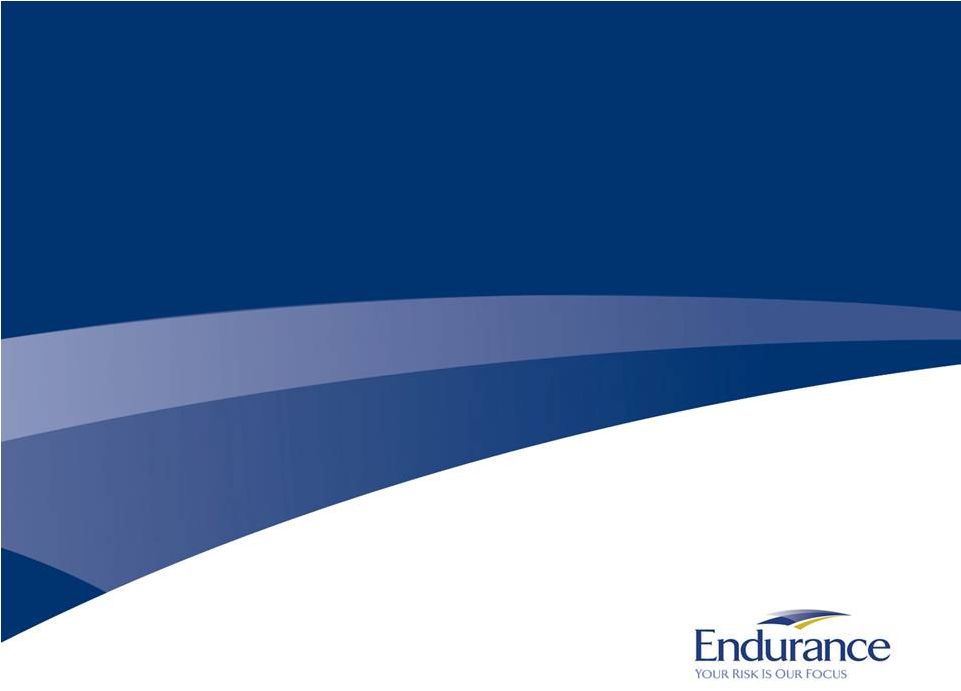 Appendix |
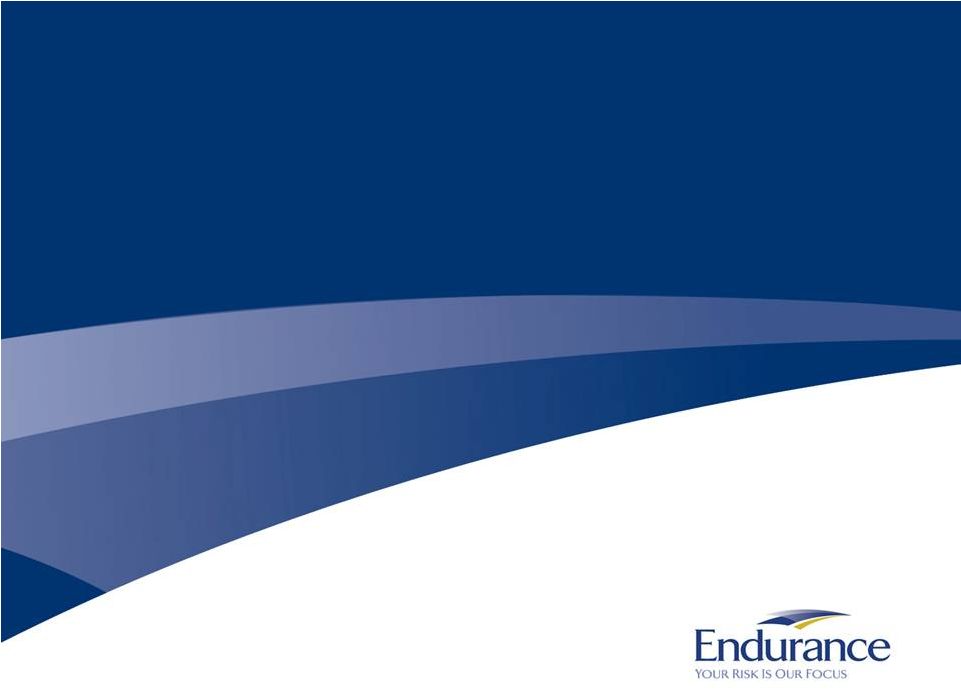 Overview of
ARMtech |
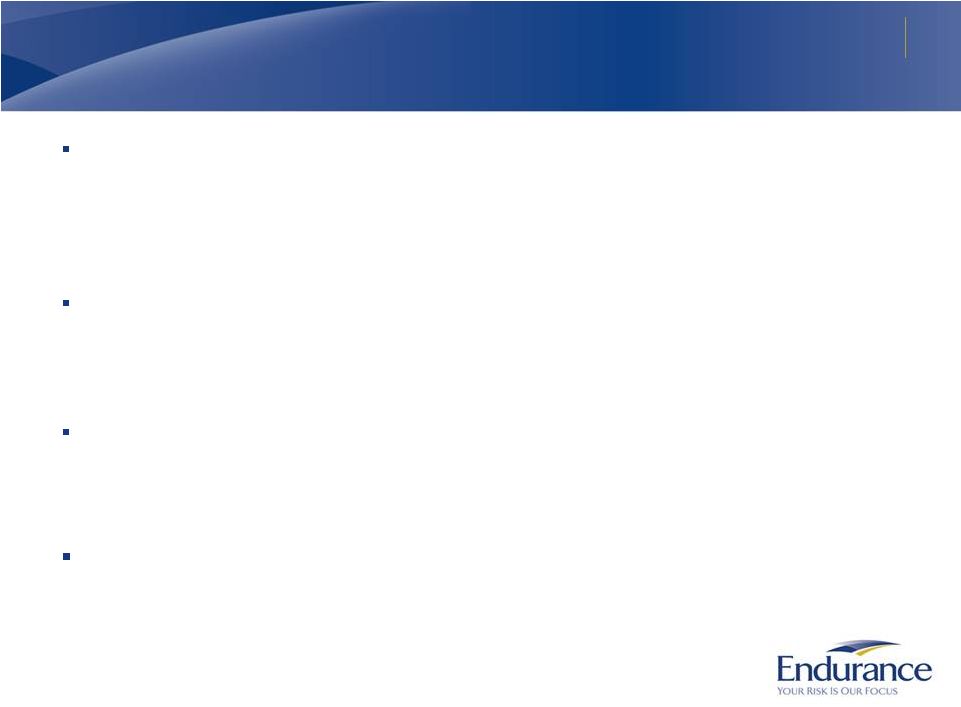 Overview of
ARMtech Acquisition of ARMtech has been a great success for Endurance
ARMtech was founded by software developers and has maintained a strong focus on providing
industry leading service through leveraging technology
•
Writes crop insurance through independent agents across 44 states
•
Based in Lubbock, Texas with historic concentration in Texas and
southern states
•
Recent growth has further balanced the portfolio geographically and by crop
ARMtech built a leading specialty crop insurance business from scratch over the last 11
years •
Approximate 7% market share and is 5
th
largest of 15 industry participants
•
Has grown to over 159,000 policies in force
•
2012 crop year* gross written premiums estimated to be $905 million
Endurance
purchased
ARMtech
in
December
2007
at
a
purchase
price
of
approximately
$125
million
•
Since the acquisition, ARMtech has generated in excess of $160 million in operating
profit •
ARMtech has grown MPCI policy count by 40.4% since 2007
Agriculture insurance provides strong return potential, diversification in Endurance’s
portfolio of (re)insurance risks and is an efficient user of capital
16
* 2012 crop year is defined as July 1, 2011 through June 30, 2012 which is the period covered
by crop insurance and reinsurance |
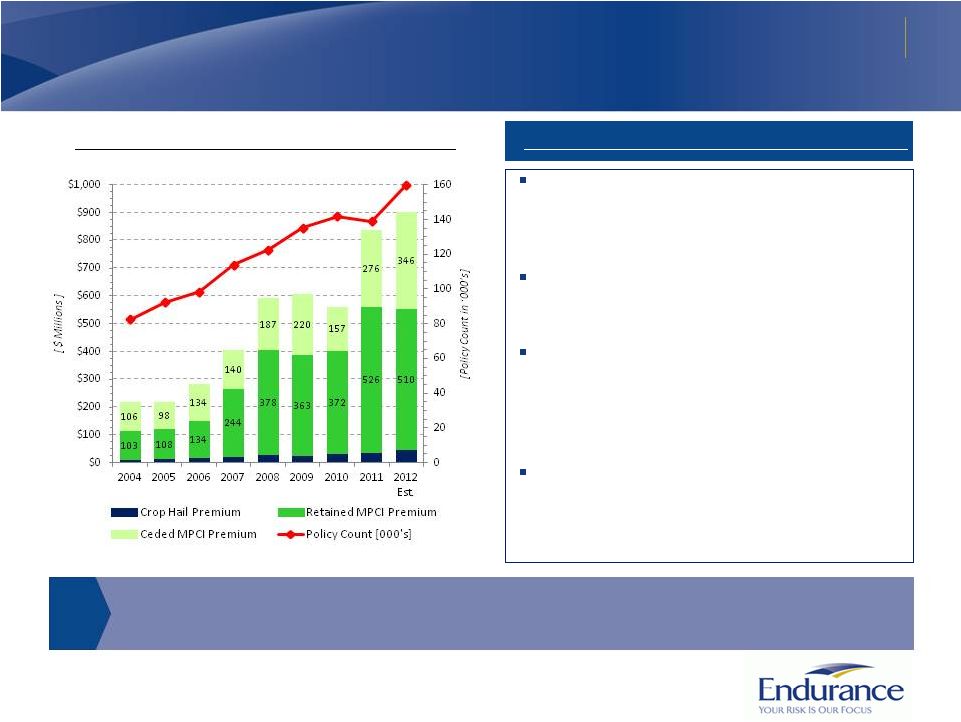 ARMtech is a
Leader in the Crop Insurance Space ARMtech’s focus on technology and service has
allowed it to steadily grow its business Written
Premiums
and
Policy
Counts
by
Crop
Year
Using
technology
and
service
to
expand
premiums
17
ARMtech has demonstrated its ability to grow market share and premiums over time through its
leading edge technology and superior delivery of service and compliance.
ARMtech has built a market leading specialty
crop insurance business through its focus on
offering excellent service supported by industry
leading technology.
Policy count has grown 40.4% over the past five
years in a line of business not subject to the
property/casualty pricing cycle.
ARMtech is a leader in using technology to
deliver high quality service and to satisfy the
very intense compliance and documentation
standards imposed on the industry by the U.S.
Federal Government.
ARMtech has generated an underwriting profit
every year since its formation. |
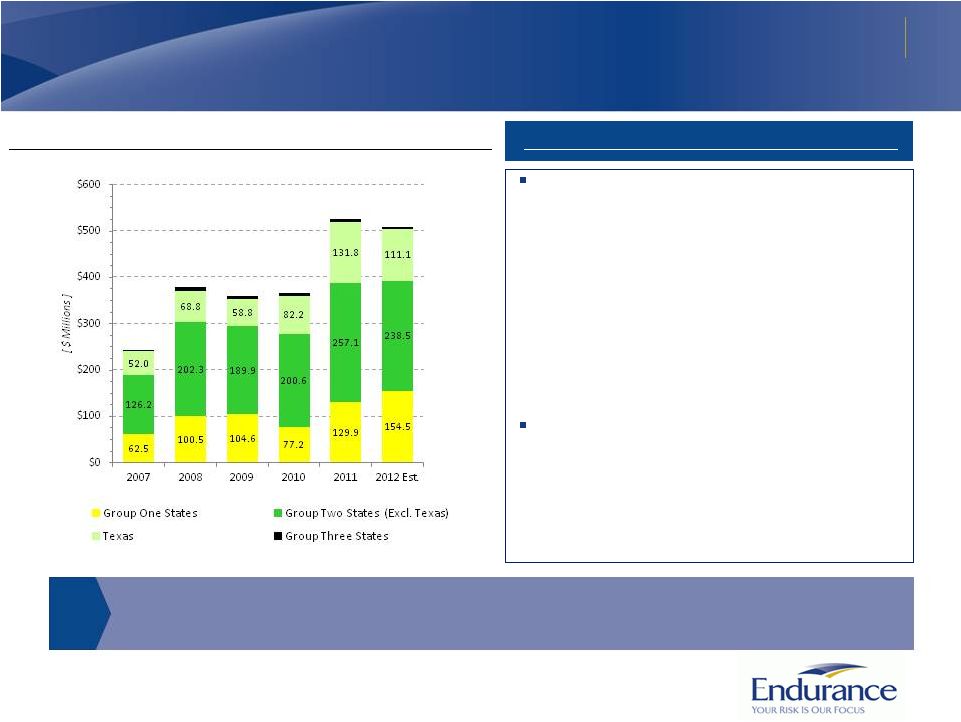 ARMtech is
Gaining Market Share in Broader Geographic Areas 2012 was a very strong marketing
year for ARMtech MPCI Net Written Premiums by Crop Year and State Grouping*
Estimated 2012 Net Written Crop Year Premiums
18
Estimated 2012 crop year MPCI net written
premiums of $509.5 million are 3.1% lower
than crop year 2011
•
Growth from geographically diverse states as
technology focused service offering is attracting
new customers and agents,
•
Partially offset by 15.7% decline in Texas due to
higher cessions, and
•
Partially offset by lower commodity prices on
corn, cotton and soybeans.
The portfolio of crop risk is more balanced in
2012 through greater crop and geographic
diversification and through greater cessions in
Texas (cotton concentration)
* Group One States –
IL, IN, IA, MN, NE
Group Two States –
States other than Group One and Group Three states
Group
Three
States
–
CT,
DE,
MA,
MD,
NV,
NH,
NJ,
NY,
PA,
UT,
WY
ARMtech continues to focus on diversifying its business geographically while managing its
exposure to Texas through active use of available reinsurance protections.
|
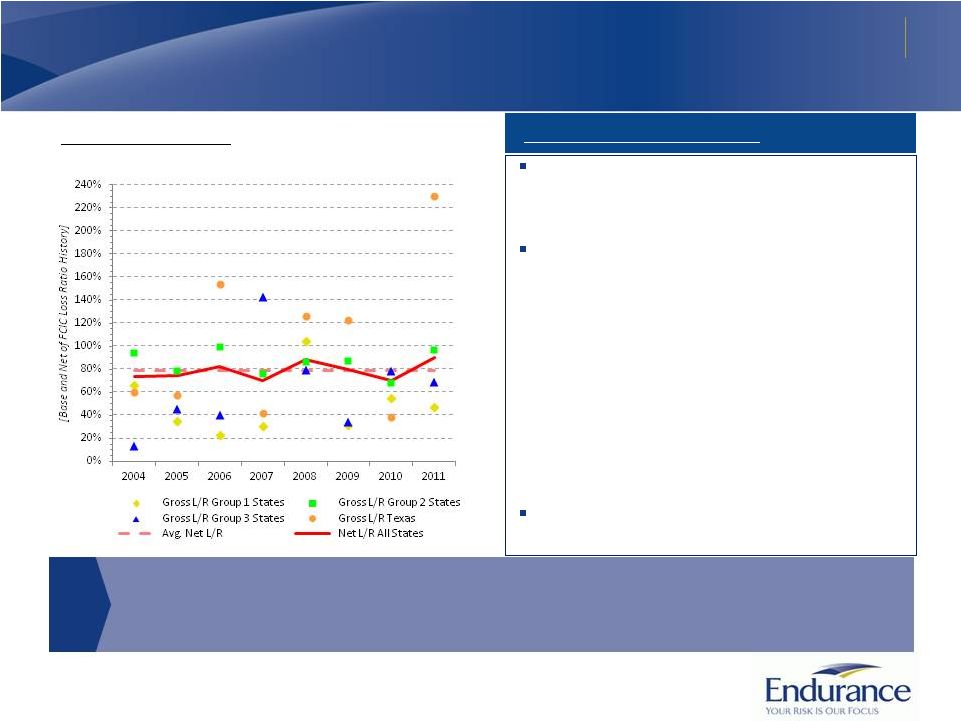 Agriculture
Insurance is Not Correlated with the P&C Business Cycle FCIC reinsurance lowers
volatility Historic
Loss
Ratio
Results
–
Pre
and
Post
Federal
Retrocessions
Stable Results in Volatile Times
19
While individual states can produce large loss
ratios, the U.S. Federal reinsurance program has
historically reduced loss ratio volatility.
ARMtech’s business has historically produced
stable profits over time after reflecting the
reinsurance terms set out in the current
standard crop reinsurance agreement
•
Historic average loss ratio post U.S. Federal
cessions has been 78.7% [adjusted for the 2011
Federal reinsurance terms]
•
The best year was 2007 with a 69.8% net loss ratio
and the worst 2011 with a 90.5% net loss ratio
•
ARMtech’s current expense run rate after the A&O
subsidy is approximately 7%
ARMtech has built a differentiated business
with high risk adjusted return potential
While individual states can produce highly varied gross loss ratios on a year to year basis,
the U.S. Federal reinsurance program has historically mitigated that volatility and
leaves ARMtech with a business which is not correlated to the traditional P&C
pricing cycle and has high risk adjusted return potential.
|
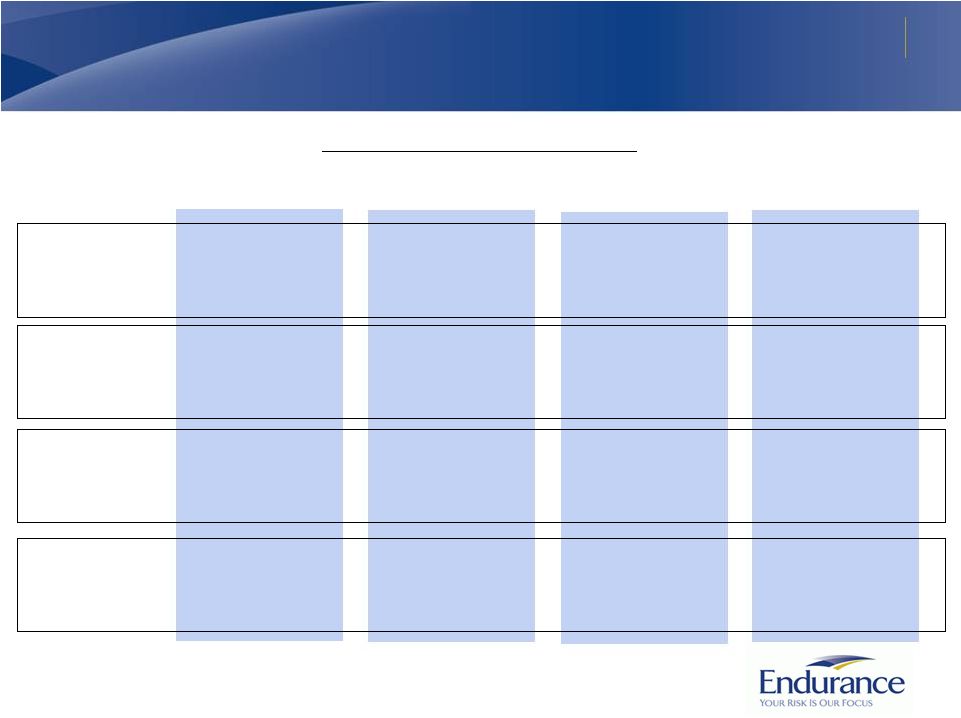 20
Overview of ARMtech
ARMtech’s recognition of premiums and earnings are influenced by growing
seasons
Seasonality of MPCI Business
Recognition of
annual written
premiums
60% -
65%
Spring crops
10% -
15%
Spring crop
adjustments due to
actual cessions
20% -
25%
Spring crop report
adjustments
Winter crops
5% -
10%
Winter crop
adjustments
Recognition of
annual earned
premiums
10%-15%
Largely driven by
winter crops
25% -
30%
Driven by spring
crops and winter
crops
30% -
35%
Largely driven by
spring crops
25% -
30%
Largely driven by
spring crops
Commodity
price setting
Setting of prices for
spring crops (forward
commodity price for
fourth quarter)
Price setting of winter
crops (forward
commodity price for
second quarter)
Harvest
Harvest of winter
crops
Harvest of spring
crops
First Quarter
Second Quarter
Third Quarter
Fourth Quarter |
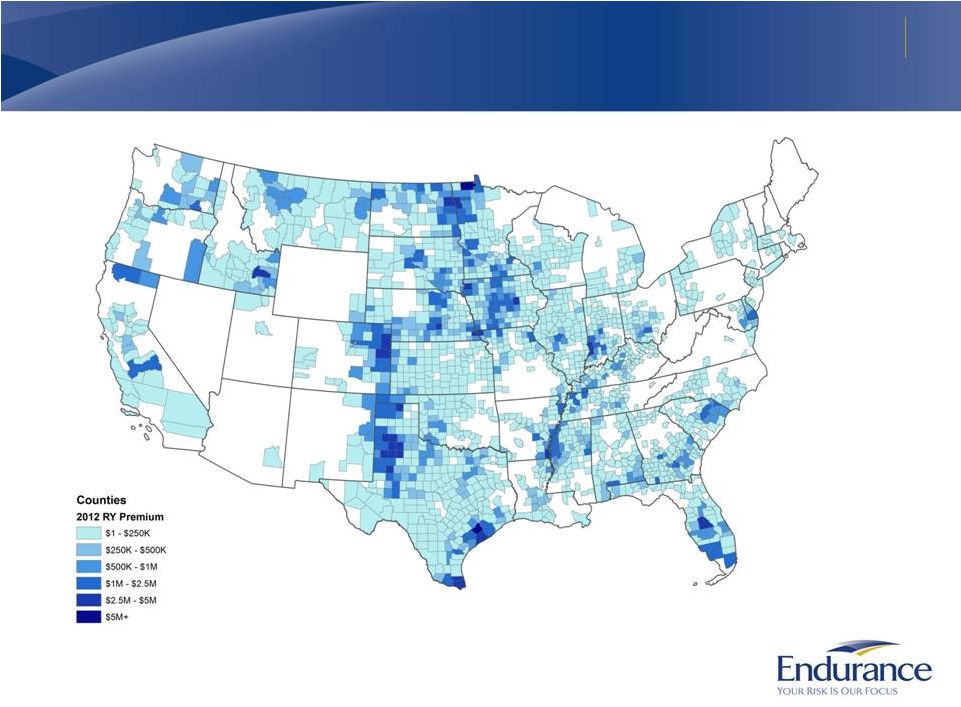 Geographic
Diversification of Crop Insurance Business ARMtech maintains a diversified portfolio of
risk both geographically and by crop 21
1.4%
2.2%
3.7%
3.4%
3.2%
1.6%
2.0%
4.1%
10.3%
1.3%
2.3%
7.6%
3.9%
2.8%
6.4%
4.8%
1.2%
1.9%
2.0%
3.0%
1.8%
21.8%
1.3%
0.9%
0.9%
0.7%
0.9%
0.6%
0.4%
0.4%
2012 Crop Year Estimated 2012 Net Written Premiums |
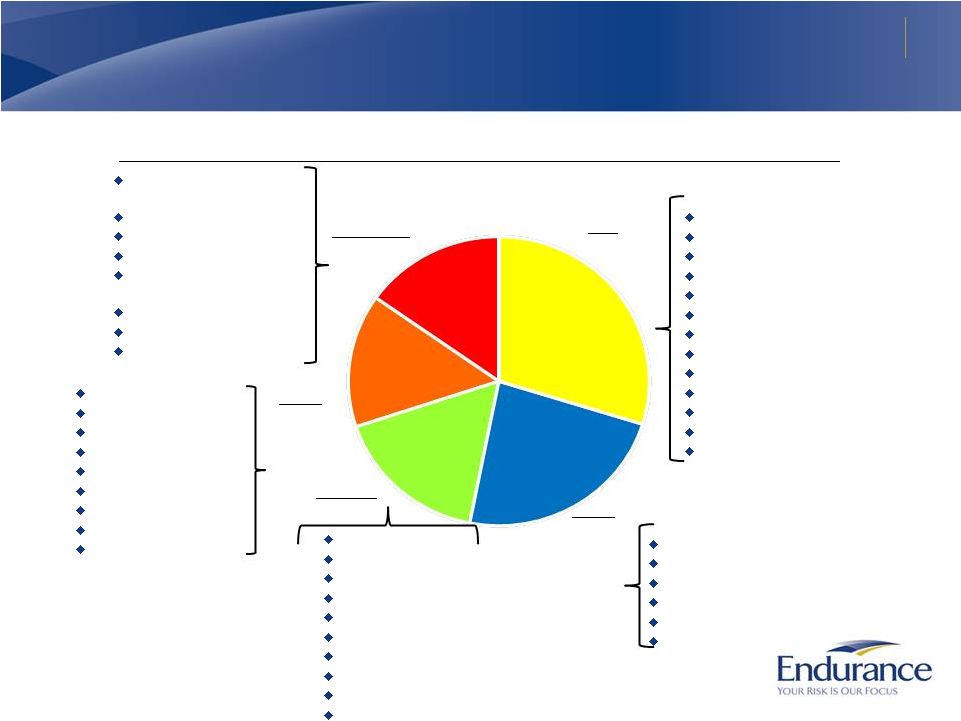 22
Diversification of Crops Within ARMtech’s Portfolio
Underwritten risks diversified by geography and commodity type
ARMtech’s Estimated 2012 Crop Year MPCI Net Written Premiums
Iowa –
7.1%
Nebraska –
4.6%
Minnesota –
3.4%
Texas –
2.8%
Indiana –
2.5%
Illinois –
1.5%
Colorado –
1.6%
Missouri –
1.5%
South Dakota –
1.5%
North Dakota –
1.2%
Kentucky –
1.0%
Mississippi –
0.8%
All other states –
4.1%
Corn
(33.6%)
Texas –
11.9%
Georgia –
1.7%
Mississippi –
1.1%
Alabama –
0.8%
South Carolina –
0.7%
All other states –
1.3%
Cotton
(17.5%)
Iowa –
3.1%
Minnesota –
2.6%
Nebraska –
1.6%
Mississippi –
1.5%
Indiana –1.5%
Missouri –
1.0%
Arkansas –
1.0%
North Dakota –
0.9%
Kentucky –
0.9%
All other states –
4.5%
Soybeans
(18.6%)
Other Crops
(17.4%)
Wheat
(12.9%)
Texas –
2.4%
Colorado –
1.8%
North Dakota –
1.5%
Minnesota –
1.0%
Idaho –
1.0%
Montana –
0.8%
Oklahoma –
0.7%
South Dakota –
0.7%
All other states –
3.0%
Citrus, Nursery & Orange
Trees -
3.2%
Grain Sorghum –
2.9%
Peanuts –
1.2%
Potatoes –
1.0%
Pasture, Rangeland, Forage –
0.9%
Apples –
0.8%
Rice –
0.7%
All other crops –
6.7% |
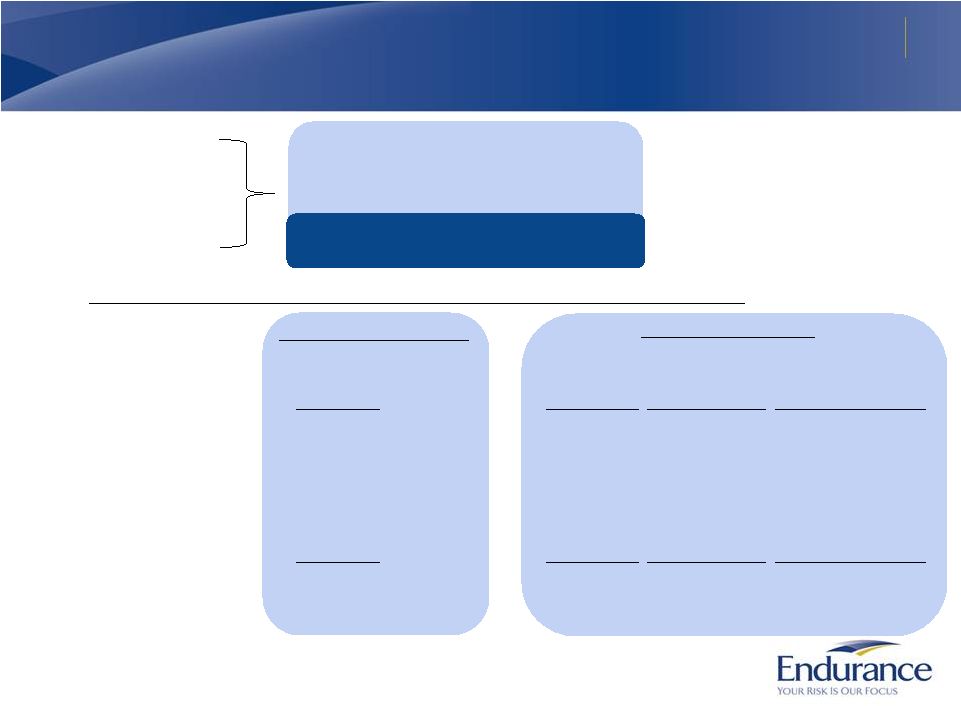 23
Agriculture Insurance Contains Three Layers of Risk Mitigation
Farmers retention, ceding premiums to the U.S. Federal Government and limitations on
losses and gains
2012 Crop Year
Gross Liability
Assigned Risk Fund
“Higher Risk Policies”
70.2% of risk retained by
ARMtech
29.8% of first dollar risk retained
by farmers
Commercial Fund
“Lower Risk Policies”
41.2% of MPCI Premiums Ceded to U.S. Federal Government
Loss Sharing
(% of loss retained by
Loss Ratio
Loss Ratio
Group 1 States
Group 2 & 3 States
ARMtech within each
100 - 160
7.5%
100 - 160
65.0%
42.5%
applicable band when
160 - 220
6.0%
160 - 220
45.0%
20.0%
the loss raio is above 100%.)
220 - 500
3.0%
220 - 500
10.0%
5.0%
Gain Sharing
(% of gain retained by
Loss Ratio
Loss Ratio
Group 1 States
Group 2 & 3 States
ARMtech within each
65 - 100
22.5%
65 - 100
75.0%
97.5%
applicable band when
50 - 65
13.5%
50 - 65
40.0%
40.0%
the loss raio is below 100%.)
0 - 50
3.0%
0 - 50
5.0%
5.0%
14.8% of 2012
Crop Year NWP
85.2% of 2012
Crop Year NWP |
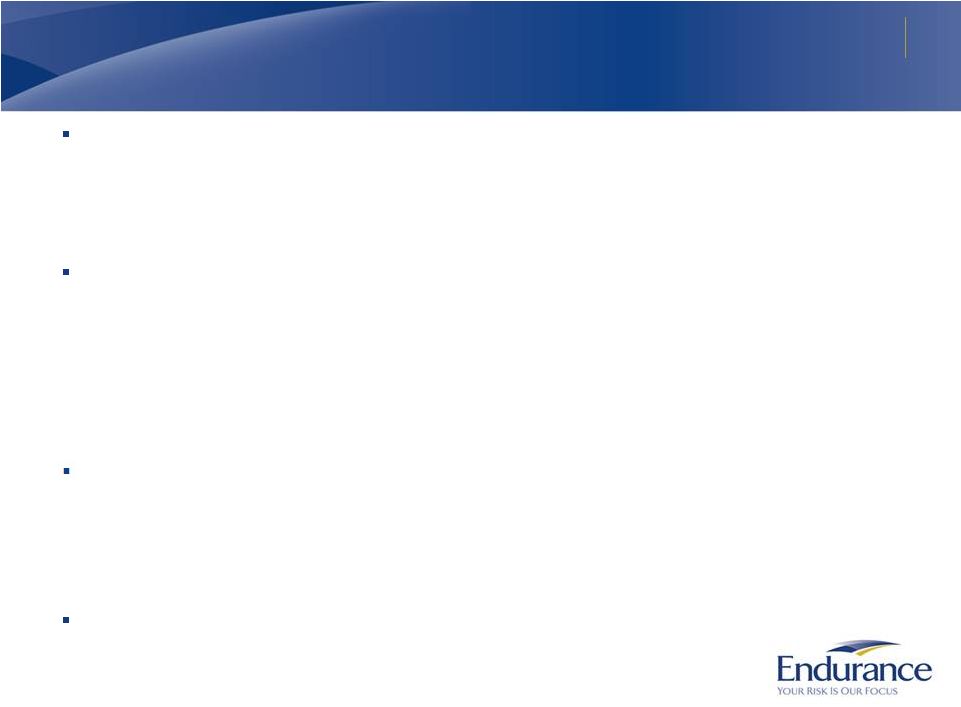 Overview of
MPCI Program Multi Peril Crop Insurance provides an essential product to American
farmers Multi Peril Crop Insurance (MPCI) is an insurance product regulated by the USDA
that provides farmers with yield or revenue protection
•
Offered by 16 licensed companies
•
Pricing is set by the government
-
no pricing cycle exists
•
Commissions payable to independent agents are capped
Premiums are directly linked to commodity prices for the underlying crops
•
As
commodity
prices
increase
or
decline
–
margins
stay
flat
but
volume
of
profits
will
increase
or
decrease
•
For crop year 2012, commodity base prices mainly declined after posting strong increases in
2011 -
Cotton declined 24.4%
-
Corn declined 5.5%
-
Wheat (fall) grew by 20.7%
-
Soybeans declined 7.0%
In recent years the MPCI program has undergone several changes:
In 2011 rates for corn and soybeans were reduced approximately 7%
•
Based on actuarial studies to recognize the favorable impact of technology improvements
•
Reductions varied by state with largest reductions being in the mid west
•
All other crops are being reviewed in 2012
24
•
Reinsurance under the standard reinsurance agreement has been simplified into two
categories •
Expense reimbursement has been reduced
•
Allowable agent commissions have been capped
•
Underserved states such as Texas have been granted rate increases
|
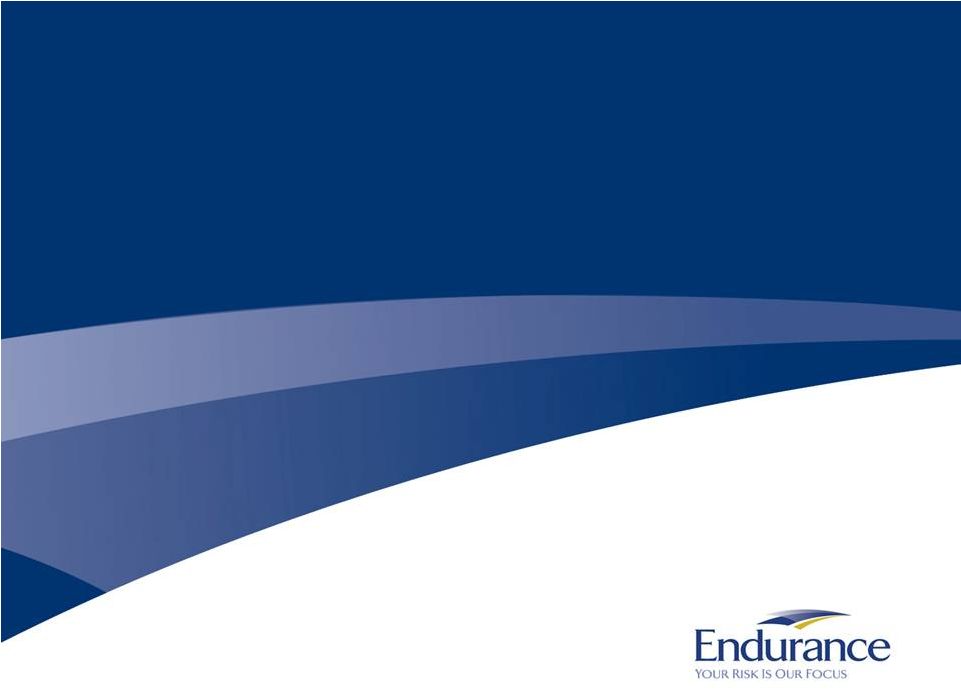 Other
Miscellaneous Information |
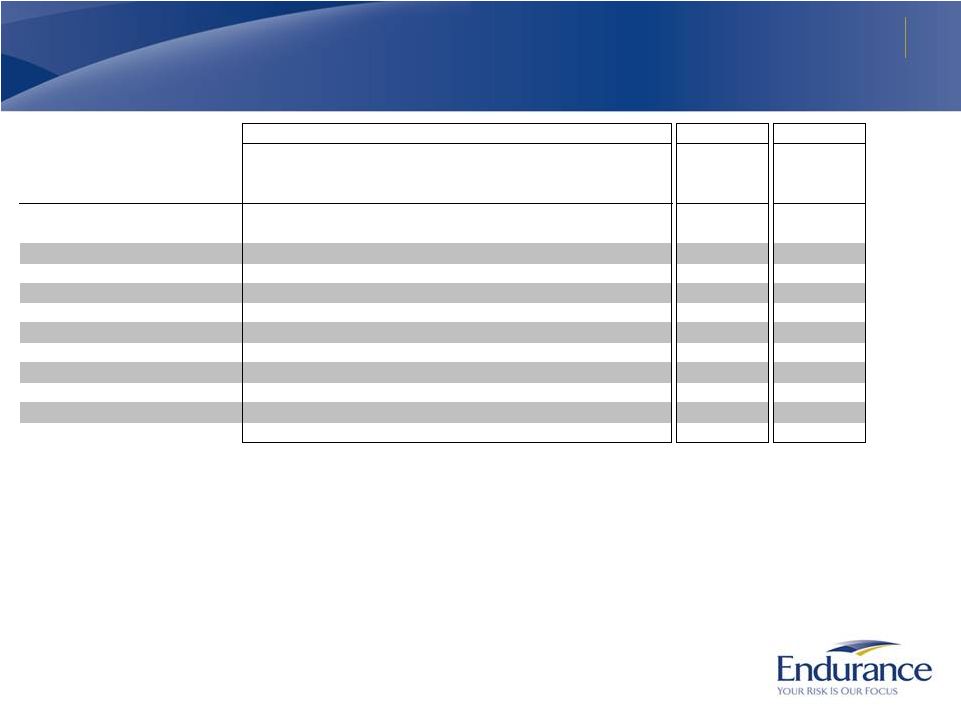 Estimated Occurrence
Net Loss as of July 1, 2012 July 1, 2011
July 1, 2010
10 Year
25 Year
50 Year
100 Year
250 Year
100 Year
100 Year
Return
Return
Return
Return
Return
Return
Return
Zone
Peril
Period
Period
Period
Period
Period
Period
Period
United States
Hurricane*
$238
$340
$407
$468
$571
$564
$510
Europe
Windstorm
104
187
260
344
456
445
399
California
Earthquake
51
228
350
412
547
442
435
Japan
Windstorm
20
104
173
247
290
268
349
Northwest U.S.
Earthquake
1
9
57
184
356
241
236
Japan
Earthquake
11
66
99
138
201
185
133
United States
Tornado/Hail
40
59
76
96
123
98
72
Australia
Earthquake
-
5
27
83
175
95
52
New Zealand
Earthquake
-
1
6
22
53
34
37
Australia
Windstorm
1
6
18
37
75
39
27
New Madrid
Earthquake
-
-
1
11
100
14
12
26
Probable Maximum Loss by Zone and Peril
Largest 1 in 100 year PML as of July 1, 2012 is equal to 17.0% of Shareholders’
Equity
as of June 30, 2012
(in millions)
Actual realized catastrophic losses could differ materially from
our net loss estimates and our net loss estimates should not be
considered as representative of the
actual losses that we may incur in connection with any particular catastrophic event.
The net loss estimates above rely significantly on computer models created to
simulate the effect of catastrophes on insured properties based upon data emanating from past
catastrophic events. Since comprehensive data collection regarding insured losses
from catastrophe events is a relatively recent development in the insurance industry, the data upon which catastrophe models is based is limited, which
has the potential to introduce inaccuracies into estimates of losses from catastrophic events,
in particular those that occur infrequently. In addition, catastrophe models are
significantly influenced by management's assumptions regarding event characteristics, construction of insured property and the cost and duration of
rebuilding after the catastrophe. Lastly, changes in Endurance's underwriting portfolio
risk control mechanisms and other factors, either before or after the date of the above
net loss estimates, may also cause actual results to vary considerably from the net loss estimates above. For a listing of risks related to Endurance and its future
performance, please see "Risk Factors" in our Annual Report on Form 10-K for the
year ended December 31, 2011. * United States Windstorm estimated net losses as of July
1, 2012 are based on RMS version 11.0 and include reinstatement premiums, if
applicable. The net loss estimates by zone above represent estimated losses related to
our property, catastrophe and aerospace and marine lines of business, based upon our
catastrophe models and assumptions regarding the location, size, magnitude, and frequency of
the catastrophe events utilized to determine the above estimates. The net loss
estimates are presented on an occurrence basis, before income tax and net of reinsurance recoveries and reinstatement premiums, if applicable. Return period
refers to the frequency with which the related size of a catastrophic event is expected to
occur. |
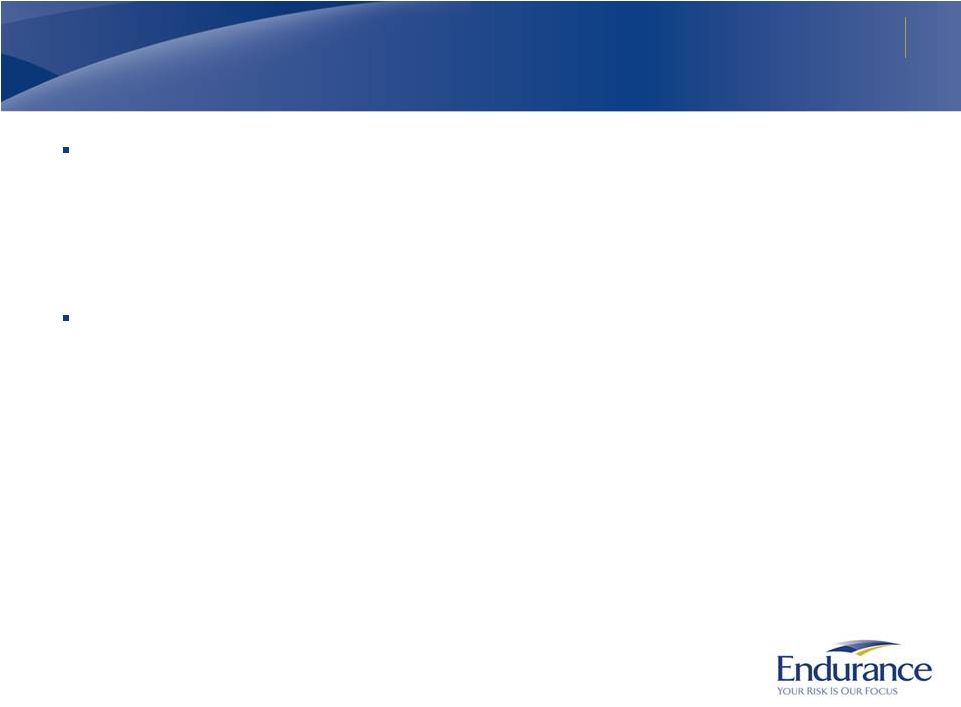 Second Quarter
2012 Highlights Risk management proved effective as catastrophe losses were within
expectations Book value per common share, adjusted for dividends, increased 3.6%
during second quarter 2012 •
Net income available to common shareholders of $64.3 million
-
Includes catastrophe losses of $14.4 million related to U.S. tornadoes and Italian
Earthquake -
Net investment income was $31.8 million, breakeven results on alternatives and lower
book yield on fixed income investments
Net written premiums of $484.4 million increased 9.7% over second quarter 2011
•
Insurance net written premiums of $186.7 million increased 7.6% from second quarter
2011 -
Growth in agriculture premiums driven by policy count growth, partially offset by lower
commodity prices
-
Reductions in property insurance premiums as we reduced our all risk insurance business line
exposures
•
Reinsurance net written premiums of $297.8 million increased 11.0% over second quarter
2011 -
Catastrophe lines grew 14.0% as higher pricing was achieved and capacity was expanded to
partially offset lower capacity deployed in our all risk insurance business line
-
Casualty grew as one contract was expanded at renewal, premium adjustments were larger than a
year ago and one contract had the renewal date shifted to 2Q12
27 |
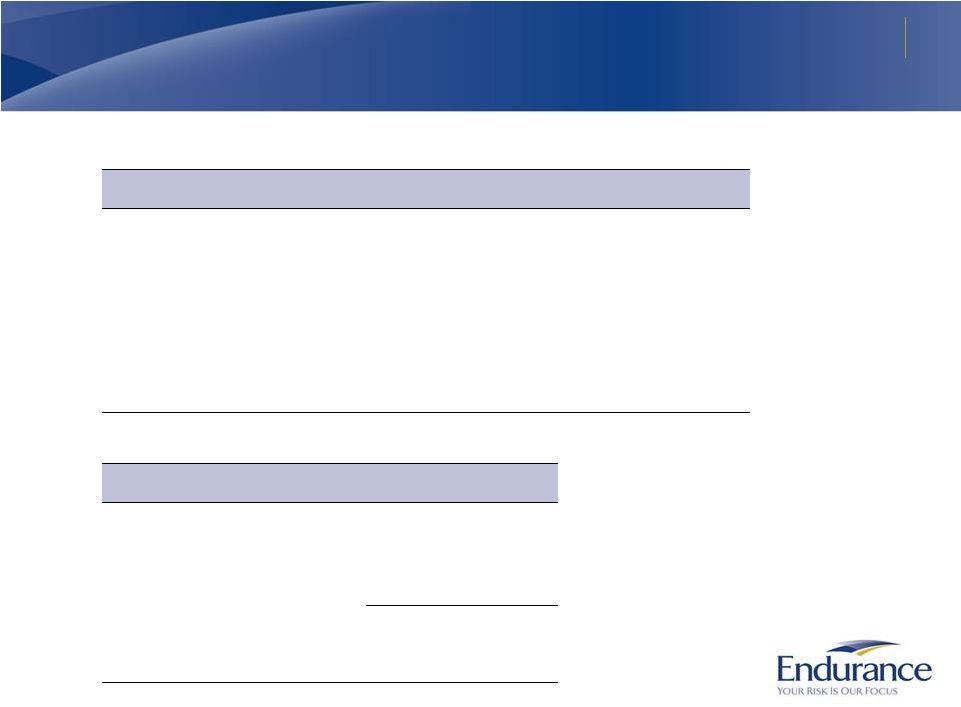 28
Financial Results for Second Quarter 2012
$MM (except per share data and %)
June 30,
2 0 1 2
June 30,
2 0 1 1
$
Change
%
Change
Net premiums written
484.4
441.8
42.6
9.7%
Net premiums earned
519.3
486.6
32.7
6.7%
Net investment income
31.8
39.8
(8.0)
-20.1%
Net underwriting income (loss)
38.7
(8.1)
46.8
579.4%
Net income
72.5
41.1
31.4
-76.5%
Operating income
59.5
24.5
35.0
-142.9%
Fully diluted net income EPS
1.48
0.87
0.61
-70.1%
Fully diluted operating income EPS
1.18
0.48
0.70
-145.8%
Financial highlights
June 30,
2 0 1 2
June 30,
2 0 1 1
Operating ROE
9.0%
3.7%
Net loss ratio
66.5%
74.4%
Acquisition expense ratio
13.9%
14.0%
General and administrative expense ratio
12.1%
13.5%
Combined ratio
92.5%
101.9%
Diluted book value per share
$53.48
$52.20
Investment leverage
2.72
2.73
Key operating ratios |
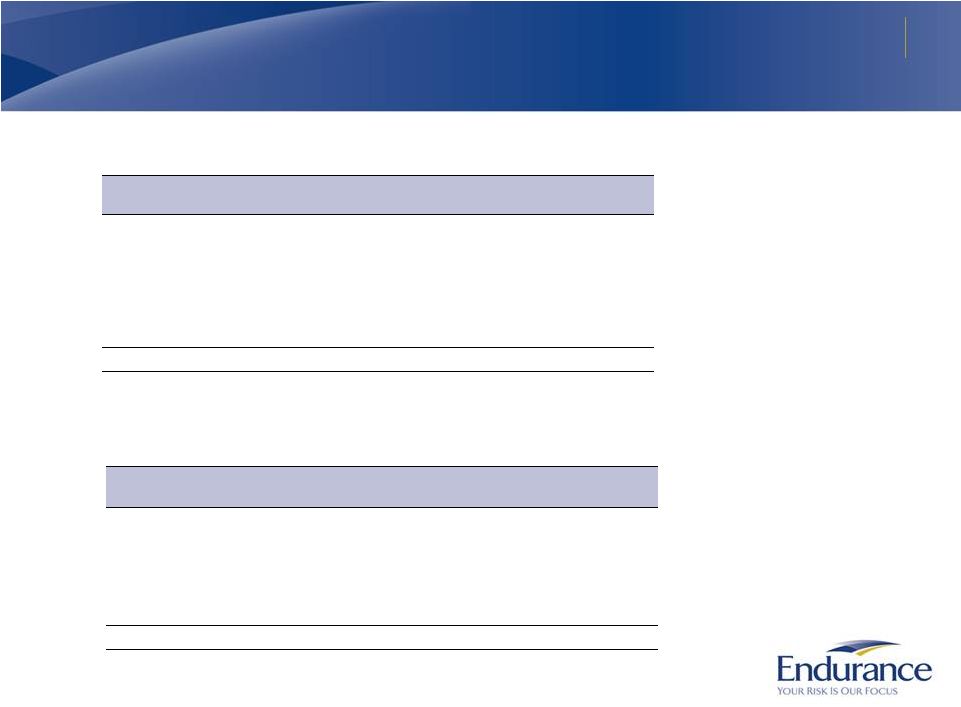 29
Second Quarter 2012 Net Written Premiums
In $MM
June 30,
2 0 1 2
June 30,
2 0 1 1
$
Change
%
Change
Property
12.0
26.0
-14.0
-53.8%
Casualty
43.5
43.8
-0.3
-0.7%
Healthcare liability
19.0
20.1
-1.1
-5.5%
Surety and other specialty
2.0
-0.1
2.1
NM
Agriculture
67.3
46.0
21.3
46.3%
Professional lines
42.8
37.7
5.4
13.5%
Total insurance
186.6
173.5
13.1
7.6%
Insurance Segment
In $MM
June 30,
2 0 1 2
June 30,
2 0 1 1
$
Change
%
Change
Casualty
58.9
45.6
13.3
29.2%
Property
54.0
52.2
1.8
3.4%
Catastrophe
158.9
139.4
19.5
14.0%
Aerospace and marine
18.3
24.7
-6.4
-25.9%
Surety and other specialty
7.7
6.4
1.3
20.3%
Total reinsurance
297.8
268.3
29.5
11.0%
Reinsurance Segment |
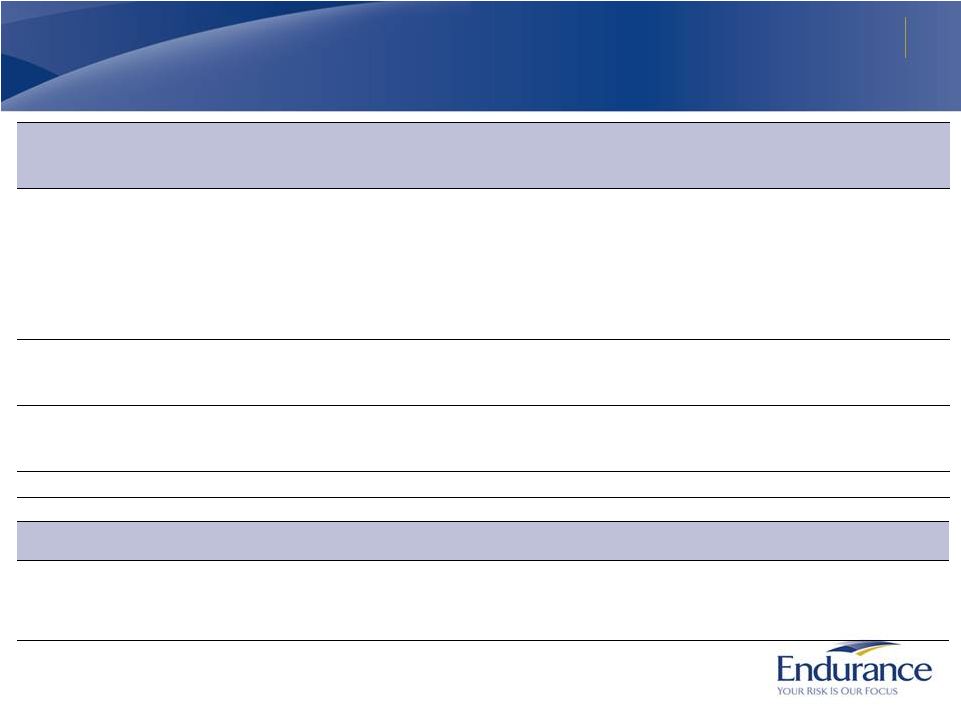 30
Financial Overview: 10 Year Financial Performance
In $MM
2002
2003
2004
2005
2006
2007
2008
2009
2010
2011
2002
through 2Q
2012
Net premiums written
765
1,598
1,697
1,619
1,586
1,575
1,784
1,606
1,764
1,980
17,301
Net premiums earned
369
1,174
1,633
1,724
1,639
1,595
1,766
1,633
1,741
1,931
16,136
Net underwriting
income (loss)
51
179
232
-410
304
322
111
265
195
-252
1,058
Net investment income
43
71
122
180
257
281
130
284
200
147
1,807
Net income (loss)
before preferred
dividend
102
263
356
-220
498
521
100
555
365
-94
2,600
Net income (loss)
available to common
shareholders
102
263
356
-223
483
506
85
539
349
-118
2,480
Diluted EPS
$1.73
$4.00
$5.28
($3.60)
$6.73
$7.17
$1.33
$9.00
$6.38
($2.95)
$38.27
Financial highlights from 2002 through June 30, 2012
Key Operating Ratios
2002
2003
2004
2005
2006
2007
2008
2009
2010
2011
Inception-to-
date
Combined ratio
86.2%
84.7%
85.8%
123.5%
81.5%
79.9%
93.5%
84.0%
88.7%
112.9%
93.4%
Operating ROE
7.8%
17.3%
19.9%
(11.9%)
25.7%
23.8%
8.5%
22.0%
12.6%
(6.3%)
11.8%
Book value per share
$21.73
$24.03
$27.91
$23.17
$28.87
$35.05
$33.06
$44.61
$52.74
$50.56 |
